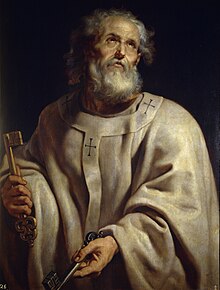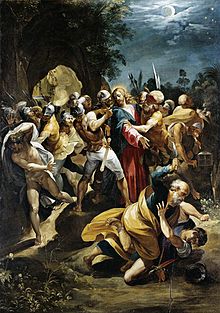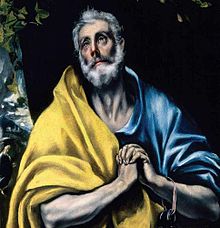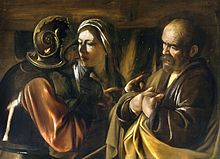
A | B | C | D | E | F | G | H | CH | I | J | K | L | M | N | O | P | Q | R | S | T | U | V | W | X | Y | Z | 0 | 1 | 2 | 3 | 4 | 5 | 6 | 7 | 8 | 9
Peter the Apostle | |
|---|---|
 Saint Peter (c. 1610–1612) by Peter Paul Rubens, depicting Peter, vested in the pallium, and holding the Keys of Heaven | |
| Church | Early Christian |
| See |
|
| Papacy began | AD 30[1] |
| Papacy ended | Between AD 64 and 68[1] |
| Successor | |
| Orders | |
| Ordination | by Jesus Christ, AD 30 |
| Personal details | |
| Born | Simeon |
| Died | Between AD 64 and 68 Vatican Hill, Rome, Italia, Roman Empire[3][4] |
| Parents | John (or Jonah; Jona) |
| Spouse | Yes, name unknown |
| Occupation | Fisherman, clergyman |
| Sainthood | |
| Feast day |
|
| Venerated in | All Christian denominations that venerate saints and in Islam |
| Canonized | Pre-Congregation |
| Attributes | Keys of Heaven, Red Martyr, pallium, papal vestments, man crucified upside down, vested as an Apostle, holding a book or scroll, Cross of Saint Peter |
| Patronage | Patronage list |
| Shrines | St. Peter's Basilica Church of St. Peter |
Saint Peter[note 1] (died AD 64–68),[1] also known as Peter the Apostle, Simon Peter, Simeon, Simon, or Cephas,[6] was one of the Twelve Apostles of Jesus Christ and one of the first leaders of the early Christian Church. He appears repeatedly and prominently in all four New Testament gospels as well as the Acts of the Apostles. Catholic tradition accredits Peter as the first bishop of Rome—or pope—and also as the first bishop of Antioch.
According to Christian tradition, Peter was crucified in Rome under Emperor Nero. The ancient Christian churches all venerate Peter as a major saint and as the founder of the Church of Antioch and the Church of Rome,[1] but they differ in their attitudes regarding the authority of his successors. According to Catholic teaching, Jesus promised Peter a special position in the Church.[7] In the New Testament, the name "Simon Peter" is found 19 times. He is the brother of Saint Andrew, and they both were fishermen. The Gospel of Mark in particular was traditionally thought to show the influence of Peter's preaching and eyewitness memories. He is also mentioned, under either the name Peter or Cephas, in Paul's First Letter to the Corinthians and the Epistle to the Galatians. The New Testament also includes two general epistles, First Peter and Second Peter, that are traditionally attributed to him, but modern scholarship generally rejects the Petrine authorship of both.[8] Nevertheless, Evangelicals and Catholics have always affirmed Peter's authorship, and recently, evangelical scholars have revived the claim of Petrine authorship of these epistles.[9]
Based on contemporary historical data, Peter's papacy is estimated to have spanned from AD 30 to his death, which would make him the longest-reigning pope, at anywhere from 34 to 38 years; however, this has never been verified.[1]
Saint Irenaeus (c. 130 – c. 202 AD) explains the Apostle Peter, his See, and his successors in book III of Adversus Haereses (Against Heresies).[10] In the book, Irenaeus wrote that Peter and Paul founded and organised the Church in Rome.[11]
Sources suggest that at first, the terms episcopos and presbyteros were used interchangeably,[12] with the consensus among scholars being that by the turn of the 1st and 2nd centuries, local congregations were led by bishops and presbyters, whose duties of office overlapped or were indistinguishable from one another.[13] Protestant and secular historians generally agree that there was probably "no single 'monarchical' bishop in Rome before the middle of the 2nd century...and likely later."[14] Outside of the New Testament, several apocryphal books were later attributed to him, in particular the Acts of Peter, Gospel of Peter, Preaching of Peter, Apocalypse of Peter, and Judgment of Peter, although scholars believe these works to be pseudepigrapha.[15][16][17]
Names and etymologies

The New Testament presents Peter's original name as Simon (/ˈsaɪmən/ ; Σίμων, Simōn in Greek). In only two passages,[18] his name is instead spelled "Simeon" (Συμεών in Greek). The variation possibly reflects "the well-known custom among Jews at the time of giving the name of a famous patriarch or personage of the Hebrew Bible to a male child along with a similar sounding Greek/Roman name ".[19]
He was later given by Jesus the name Cephas (/ˈsiːfəs/[20]), from the Aramaic כֵּיפָא, Kepha, 'rock/stone'. In translations of the Bible from the original Greek, his name is maintained as Cephas in nine occurrences in the New Testament,[21] whereas in the vast majority of mentions (156 occurrences in the New Testament) he is called Πέτρος, Petros, from the Greek and Latin word for a rock or stone (petra)[22] to which the masculine ending was added, rendered into English as Peter.[23]
The precise meaning of the Aramaic word is disputed, some saying that its usual meaning is "rock" or "crag", others saying that it means rather "stone" and, particularly in its application by Jesus to Simon, like a "jewel", but most scholars agree that as a proper name, it denotes a rough or tough character...[24] Both meanings, "stone" (jewel or hewn stone) and "rock", are indicated in dictionaries of Aramaic[25] and Syriac.[26]
Catholic theologian Rudolf Pesch argues that the Aramaic word would mean "precious stone" to designate a distinguishing person.[27][28] This cannot be sufficiently proven from Aramaic, however, since the use of the Aramaic root kp as a personal name has not been proven and there are hardly any known examples of the word being used to mean "precious stone".[29]
The combined name Σίμων Πέτρος (Símon Pétros, Simon Peter) appears 19 times in the New Testament. In some Syriac documents he is called, in English translation, Simon Cephas.[30]
Biographical information

Sources
The sources used to reconstruct the life of Peter can be divided in three groups:
- the New Testament writings, such as the Pauline Epistles (where Paul the Apostle calls him "Cephas" and "Peter"), the Petrine Epistles (traditionally attributed to him, but their authorship is disputed), the Canonical Gospels and the Acts of the Apostles;
- the New Testament apocrypha attributed to him, such as the Gospel of Peter, the Preaching of Peter, the Acts of Peter, the Acts of Peter and Andrew, the Acts of Peter and the Twelve, the Acts of Peter and Paul, the Letter of Peter to Philip, the Letter of Peter to James the Just, the Apocalypse of Peter and the Coptic Apocalypse of Peter. Scholars agree that these are late pseudepigrapha with little historical value, though they may contain some historical kernel;
- the writing of the Apostolic Fathers and the Church Fathers, such as Papias of Hierapolis, Pope Clement I, Polycarp, Ignatius of Antioch and Ireneus.
In the New Testament, he is among the first[note 2] of the disciples called during Jesus' ministry. Peter became the first listed apostle ordained by Jesus in the early Church.[35]
Accounts

Peter was a Jewish fisherman in Bethsaida (John 1:44).[37] He was named Simon, the son of a man named Jonah or John.[note 3] The three Synoptic Gospels recount how Peter's mother-in-law was healed by Jesus at their home in Capernaum (Matthew 8:14–17,[40] Mark 1:29–31,[41] Luke 4:38);[42] this passage clearly depicts Peter as being married or widowed. 1 Corinthians 9:5[43] has also been taken to imply that he was married.[44]

In the Synoptic Gospels, Peter (then Simon) was a fisherman along with his brother, Andrew, and the sons of Zebedee, James and John. The Gospel of John also depicts Peter fishing, even after the resurrection of Jesus, in the story of the Catch of 153 fish. In Matthew and Mark, Jesus called Simon and his brother Andrew to be "fishers of men" (Matthew 4:18–19,[45] Mark 1:16–17).[46]
In the Confession of Peter he proclaims Jesus to be the Christ (Jewish Messiah), as described in the three Synoptic Gospels: Matthew 16:13–20,[47] Mark 8:27–30[48] and Luke 9:18–21.[49] It is there, in the area of Caesarea Philippi, that he receives from Jesus the name Cephas (Aramaic Kepha), or Peter (Greek Petros).
In Luke, Simon Peter owns the boat that Jesus uses to preach to the multitudes who were pressing on him at the shore of Lake Gennesaret (Luke 5:3).[50] Jesus then amazes Simon and his companions James and John (Andrew is not mentioned) by telling them to lower their nets, whereupon they catch a huge number of fish. Immediately after this, they follow Him (Luke 5:4–11).[51] The Gospel of John gives a comparable account of "The First Disciples" (John 1:35–42).[52] In John, the readers are told that it was two disciples of John the Baptist (Andrew and an unnamed disciple) who heard John the Baptist announce Jesus as the "Lamb of God" and then followed Jesus. Andrew then went to his brother Simon, saying, "We have found the Messiah", and then brought Simon to Jesus, who immediately, at the first sight of him, named him as "Cephas". (John 1:42).[38]

Three of the four gospels—Matthew, Mark and John—recount the story of Jesus walking on water. Matthew additionally describes Peter walking on water for a moment but beginning to sink when his faith wavers (Matthew 14:28–31).[53]
At the beginning of the Last Supper, Jesus washed His disciples' feet. Peter initially refused to let Jesus wash his feet, but when Jesus told him: "If I wash thee not, thou hast no part with me", Peter replied: "Lord, not my feet only, but also my hands and my head" (John 13:2–11).[54] The washing of feet is often repeated in the service of worship on Maundy Thursday by some Christian denominations.
The three Synoptic Gospels all mention that, when Jesus was arrested, one of his companions cut off the ear of a servant of the High Priest of Israel (Matthew 26:51,[55] Mark 14:47,[56] Luke 22:50).[57] The Gospel of John also includes this event and names Peter as the swordsman and Malchus as the victim (John 18:10).[58] Luke adds that Jesus touched the ear and miraculously healed it (Luke 22:49–51).[59] This healing of the servant's ear is the last of the 37 miracles attributed to Jesus in the Bible.
Simon Peter was twice arraigned, with John, before the Sanhedrin and directly defied them (Acts 4:7–22,[60] Acts 5:18–42).[61] Peter takes a missionary journey to Lydda, Joppa and Caesarea (Acts 9:32–Acts 10:2).[62] At Joppa, Peter had a vision given him from God which allowed for the eating of previously unclean animals, leading the early believers to the decision to evangelise the Gentiles (Acts 10).[63] Simon Peter applied the message of the vision on clean animals to the gentiles and follows his meeting with Cornelius the Centurion by claiming that "God shows no partiality".
According to the Acts of the Apostles, Peter and John were sent from Jerusalem to Samaria (Acts 8:14).[64] Peter/Cephas is mentioned briefly in the opening chapter of one of the Pauline epistles, Epistle to the Galatians, which mentions a trip by Paul the Apostle to Jerusalem where he meets Peter (Galatians 1:18).[65] Peter features again in Galatians, fourteen years later, when Paul (now with Barnabas and Titus) returned to Jerusalem (Galatians 2:7–9).[66] When Peter came to Antioch, Paul opposed Peter to his face "because he was in the wrong" (Galatians 2:11).[67][note 4]

Acts 12 narrates how Peter, who was in Jerusalem, was put into prison by Agrippa I (AD 42–44) but was rescued by an angel. After his liberation Peter left Jerusalem to go to "another place" (Acts 12:1–18).[68] Concerning Peter's subsequent activity there is no further connected information from the extant sources, although there are short notices of certain individual episodes of his later life.[1]
Peter's wife
Synoptic Gospels mention that Peter had a mother-in-law at the time he joined Jesus, and this mother-in-law was healed by Him.[69] However, the Gospels give no information about his wife. Clement of Alexandria claimed his wife was executed for her faith by the Roman authorities but does not specify any date or location.[70] Another opinion states that Peter's wife was no longer alive at the time he met Jesus, so he was a widower.[71]
First leader of the early Church
The Gospels and Acts portray Peter as the most prominent apostle, though he denied Jesus three times during the events of the crucifixion. According to the Christian tradition, Peter was the first disciple to whom Jesus appeared, balancing Peter's denial and restoring his position. Peter is regarded as the first leader of the early Church,[72][73] though he was soon eclipsed in this leadership by James the Just, "the brother of the Lord".[74][75] Because Peter was the first to whom Jesus appeared, the leadership of Peter forms the basis of the Apostolic succession and the institutional power of orthodoxy, as the heirs of Peter,[76] and he is described as "the rock" on which the church will be built.[72]
Position among the apostles

Peter is always listed first among the Twelve Apostles in the Gospels[77] and in the Book of Acts.[78] Along with James the Elder and John he formed an informal triumvirate within the Twelve Apostles. Jesus allowed them to be the only apostles present at three particular occasions during his public ministry, the Raising of Jairus' daughter,[79] Transfiguration of Jesus[80] and Agony in the Garden of Gethsemane.[81] Peter often confesses his faith in Jesus as the Messiah.
Peter is often depicted in the gospels as spokesman of all the Apostles.[82] John Vidmar, a Catholic scholar, writes: "Catholic scholars agree that Peter had an authority that superseded that of the other apostles. Peter is their spokesman at several events, he conducts the election of Matthias, his opinion in the debate over converting Gentiles was crucial, etc."[83]
The author of the Acts of the Apostles portrays Peter as the central figure within the early Christian community.[note 5]
Denial of Jesus by Peter


All four canonical gospels recount that, during the Last Supper, Jesus foretold that Peter would deny him three times before the following cockcrow ("before the cock crows twice" in Mark's account). The three Synoptics and John describe the three denials as follows:
- A denial when a female servant of the high priest spots Simon Peter, saying that he had been with Jesus. According to Mark (but not in all manuscripts), "the rooster crowed". Only Luke and John mention a fire by which Peter was warming himself among other people: according to Luke, Peter was "sitting"; according to John, he was "standing".
- A denial when Simon Peter had gone out to the gateway, away from the firelight, but the same servant girl (per Mark) or another servant girl (per Matthew) or a man (per Luke and also John, for whom, though, this is the third denial) told the bystanders he was a follower of Jesus. According to John, "the rooster crowed". The Gospel of John places the second denial while Peter was still warming himself at the fire and gives as the occasion of the third denial a claim by someone to have seen him in the garden of Gethsemane when Jesus was arrested.
- A denial came when Peter's Galilean accent was taken as proof that he was indeed a disciple of Jesus. According to Matthew, Mark and Luke, "the rooster crowed". Matthew adds that it was his accent that gave him away as coming from Galilee. Luke deviates slightly from this by stating that, rather than a crowd accusing Simon Peter, it was a third individual. John does not mention the Galilean accent.
In the Gospel of Luke is a record of Christ telling Peter: "Simon, Simon, behold, Satan hath desired to have you, that he may sift you as wheat: but I have prayed for thee, that thy faith fail not: and when thou art converted, strengthen thy brethren." In a reminiscent[89] scene in John's epilogue, Peter affirms three times that he loves Jesus.
Zdroj:https://en.wikipedia.org?pojem=Saint_Peter
Text je dostupný za podmienok Creative Commons Attribution/Share-Alike License 3.0 Unported; prípadne za ďalších podmienok. Podrobnejšie informácie nájdete na stránke Podmienky použitia.
Antropológia
Aplikované vedy
Bibliometria
Dejiny vedy
Encyklopédie
Filozofia vedy
Forenzné vedy
Humanitné vedy
Knižničná veda
Kryogenika
Kryptológia
Kulturológia
Literárna veda
Medzidisciplinárne oblasti
Metódy kvantitatívnej analýzy
Metavedy
Metodika
Text je dostupný za podmienok Creative
Commons Attribution/Share-Alike License 3.0 Unported; prípadne za ďalších
podmienok.
Podrobnejšie informácie nájdete na stránke Podmienky
použitia.
www.astronomia.sk | www.biologia.sk | www.botanika.sk | www.dejiny.sk | www.economy.sk | www.elektrotechnika.sk | www.estetika.sk | www.farmakologia.sk | www.filozofia.sk | Fyzika | www.futurologia.sk | www.genetika.sk | www.chemia.sk | www.lingvistika.sk | www.politologia.sk | www.psychologia.sk | www.sexuologia.sk | www.sociologia.sk | www.veda.sk I www.zoologia.sk
